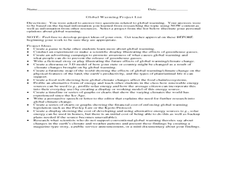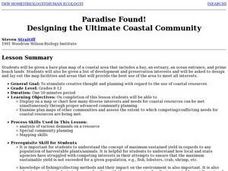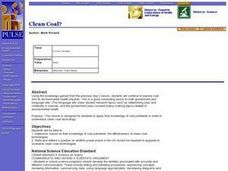Curated OER
Energy Sources
Students identify natural resources and describe the difference between renewable and non-renewable resources. They also identify the disadvantages and advantages of the resources.
Curated OER
GLOBAL WARMING
Students form definitions of the greenhouse effect based on prior knowledge, class discussion, viewing diagrams, and participate in group brainstorming sessions and class discussions related to the impact of the greenhouse effect and...
Curated OER
Environment: The River Classroom
Seventh graders engage in hands-on experiments and activities dealing with rivers and greenways. They also observe lectures and demonstrations by experts in water and river restoration. Students and teachers participate in canoe trips...
Curated OER
Case Study--"What Good Is It?"
Students receive a realistic introduction to the intricacies of the endangered species problem. Students examine and refine personal concepts of non-utilitarian value and biocentric stewardship. Students examine what, if any, duties the...
Curated OER
Electromagnetic Spectrum
High schoolers define electromagnetic radiation, list major categories and uses of electromagnetic waves, identify potential health risks with electromagnetic waves, and demonstrate understanding of Plank's constant by solving...
Curated OER
Comparing the Impact of Multiple Uses
Students study multiple land uses and their effects on one another. They assess multiple land uses in National Forests and Grasslands and evaluate the effects of each use on all other uses. They develop a comprehensive list of human...
Curated OER
Ethical and Critical Thinking: Genetically Modified Food
Students read statements representing different points of view on Genetically Modified Food. They identify the "facts" and "opinions" in each statement, and then briefly summarize the issue of Genetically Modified Food in a short...
Curated OER
Bird Identification Worksheet 2
In this bird activity, learners cross reference materials gathered to identify the bird pictured and fill in 7 boxes with the information gathered.
Curated OER
Pond Dipping: Worksheet 1
In this environment worksheet, students put a tick in the tally box when they find 1 of 7 pond creatures as they experiment with the process of going pond dipping.
Curated OER
Environment or Economy?
Students develop counterarguments to John Mizzoni's article on business sustainability. In this economics vs. environment lesson, students present examples of greenwashing and support them with rationale. They also discuss whether...
Curated OER
The Global Impact of Insect Borne Diseases & Agriculture
Students study the global impact of insect borne diseases, the appropriate use of pesticides, and the concept of human interrelations on a world wide scale. They examine how to safely apply a pesticide, according to the label.
Curated OER
Can You Find a Solution?
Learners explore the topic of public conservation. In this Florida panthers lesson, students read a scenario about the endangered panther and collaborate to plan a way to protect the panther population. Learners also participate in a...
Curated OER
Lesson Plan: Global Warming
Students explore the concept of global warming. In this climate change lesson plan, students explore the provided links to PBS NOW sources and research the greenhouse effect and the effects of global warming. Students support their...
Curated OER
Carbon Dioxide Heats It Up
Young scholars design an investigation to test whether vegetation in an area helps regulate the ambient air temperature. They make comparisons between the investigation and global changes in climate. In groups, they present their...
Curated OER
Believe It...Or Not
Pupils critically analyze data regarding climate changes using a glossary of terms generated by examination of climate related articles. They examine and graph climatic data, and discuss, hypothesize and test apparent discrepancies in...
Curated OER
Foodborne Illness Educational Materials
Students work in teams to research and create educational material succinctly summarizing known salient fact, including prevention, of a particular foodborne illness. Pupils educational materials are presented in both oral and written...
Curated OER
Mutations--Preexisting or Acquired?
Students state the controls and variables of the Newcombe spread experiment. They state a hypothesis for the Newcombe spread experiment. Students distinguish between the characteristics of a preexisting mutations and those of an...
Curated OER
Mutations--Preexisting or Acquired?
Students explore the reasoning and experimental approaches to mutations. They expose a culture of E. coli to virulent bacteriophage and observe whether mutations of the cells existed previously or if the bacteria mutated as a response...
Curated OER
Creating a Coastal Area
Students design and lay out a map of a coastal area that includes a bay, an estuary, an ocean entrance, and prime beach lands. They write a plan outlining solutions to the economic problems of their community and present their map and...
Curated OER
Animal Word Search
In this animal word search worksheet, students locate the following words in the word search puzzle: damselfly, duckweed, mallard, newt, kingfisher, otter, mayfly, leech, amphibian, salmon, and dipper.
Curated OER
Arsenic Contamination: Water Filtration
Students work in groups to design a filtration process that will separate clean water from polluted water. They organize data in tables or graphs and present their findings to the class. Students identify further safety protocols that...
Curated OER
Clean Coal?
Students determine, based on their knowledge of coal pollutants, the effectiveness of clean-coal technologies. They state and defend a position on whether power plants in the United States should be required to upgrade to available...
Curated OER
What Are the Ethical and Legal Aspects of Radon?
Students research a legal or ethical aspect of radon. They create their own legislation regarding radon and real estate. They present their information to the class.
Curated OER
Genetically Modified Crops
Students recognize the difference between negative and positive externalties. They diagram reasons for market failures pertaining to genetically altered crops.























